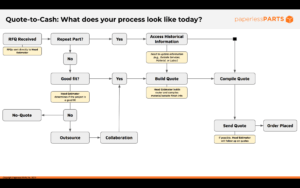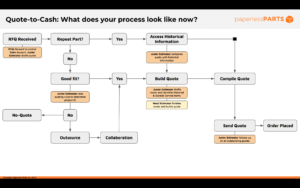
Why Bringing a Junior Estimator into the Quoting Process Will Transform Your Business
The Problem
It is a dilemma we see all the time here at Paperless Parts: a shop has one estimator that has been doing their job, among other responsibilities like engineering, inside sales, managing, etc., for several decades. They have a consistent quoting process which has allowed the company to scale to its current size, but this process can be slow. This makes it challenging to get all their quotes done. Furthermore, the current system has a high learning curve, which makes it difficult to bring in a junior estimator with minimal manufacturing and estimating experience to help handle the load. To achieve the company’s goals, the team needs a quoting solution that ensures the consistency and accuracy of their current system, increases speed to improve their output, and enables a new estimator to transition into the quoting process.
Why Does it Matter?
It is critical that the most skilled shop personnel reserve their time and knowledge for the opportunities where their unique ability is required and can make the biggest impact on the company. The Head Estimator often has the most manufacturing and business experience in the shop. This is why they are entrusted with the most sensitive and important customer-facing interaction – quoting. After working with hundreds of shops, we’ve built a sketch of this typical quoting process.

The Head Estimator is often responsible for facilitating every step in this process (their primary actions are highlighted in yellow in Figure 1). This includes the repetitive administrative steps required to build a quote: compile all materials (all relevant files, customer notes, desired quantities, etc.), determine project fit, draft the quote in their ERP/MRP or alternative quoting system, and begin to build the router. This individual’s wealth of skill and experience could certainly be better applied in other areas of the business!
Let’s say the average quote-item takes 15 minutes to build. If the Head Estimator was able to save 50% of their time usually devoted to the administrative tasks involved in the quoting process, they would save 7.5 minutes on every quote-item. Assuming roughly 50 quote-items a week (depending on shop size/volume), this comes to over 6 hours a week! Imagine all the projects one of the most skilled team members in a shop could complete with 6 extra hours a week?
How Does Paperless Parts Solve The Problem?
Paperless Parts takes a very structured approach to implementing this solution. First, we review the team’s current quoting process to identify friction points and opportunities. Then, we train the Junior Estimator in Paperless Parts. Next, we work with the Head Estimator to build rules or ‘guardrails’ into the quoting process. Lastly, we review further training opportunities to bridge the Skills Gap. This process produces a wonderful synergy between consultative support and a fast, customized software implementation.
Process Map
The first step in onboarding is the Process Map – defining the team’s current quoting process (see Figure 1 for a typical sketch). This enables us to make calculated, intentional decisions together which deliver the most value for each team. Where is the most administrative work? What steps in the process take the most time? Can someone else handle these responsibilities? Where can we leverage the geometry of the model? These questions help define the tasks in the quoting process that a Junior Estimator can handle. It also helps to build a completely customized solution for each shop.
Training
Now that we’ve defined the Junior Estimator’s responsibilities, it is time to train them. Forget the high learning curve of existing quoting systems and processes – Paperless Parts is a super easy-to-use platform. We’ve seen individuals with little software experience learn how to use the platform in days. Once the Junior Estimator is trained in their responsibilities, we’ll review and confirm the team’s new Process Map. A typical sketch of the new Process Map is below – the Junior Estimator’s responsibilities are highlighted in orange. The Head Estimator’s time is now reserved exclusively for the tasks in the quoting process which require their unique ability – defining complex setup time, cycle time, and configuring the router.

Quoting Rules
One of Paperless Parts’ most powerful features is its ability to bridge the Skills Gap by capturing tribal knowledge. Tribal knowledge refers to those small, near instinctual pieces of expertise that individuals gain through decades of experience in a shop. It relates directly to the Skills Gap, and replicating it is often a shop owner’s greatest concern. By defining completely customized formulas or ‘rules’ for quoting, we are able to capture these pieces of expertise and apply them to the quoting process. Some examples of these quoting rules include:
- If a hole’s diameter is greater than 3 inches, trigger DFM (Design-for-Manufacturability) warning. If the part has more than 50 DFM warnings, set quote-item to Level 2.
- If the quote-item’s desired quantity is greater than 50, decrease the labor rate by 20%.
- If a part has more than 50 features, set it to Level 2.
- If the part’s dimensions exceed our machine thresholds, no quote it.
These sort of rules apply equally well for information stored on PDFs, which of course cannot be interrogated. These quote-items just require a bit of manual entry. For example:
- If the maximum tolerance exceeds +/- 0.0005, set the quote-item to Level 3.
- If the number of certifications exceeds 5, increase Inspection Setup Time by 3 hours.
By defining quoting rules or ‘guardrails’, we can create a framework that allows the shop to filter quotes into different levels of complexity. This informs a more structured and intelligent quoting process. What’s more, these rules are not pulled from some arbitrary, global database; they are built based on the Head Estimator’s tribal knowledge. This process produces a smooth and completely customized workflow. The Junior Estimator will see each quote-item’s part level based on the geometrically defined rules or manual inputs of the project. This information is then documented in the quote’s Internal Notes and clearly displayed in the Quotes Dashboard. The Head Estimator can then quickly see which quotes are more complex and which customer each quote is for, and take action accordingly. Thus, the Head Estimator is able to intelligently apply their time and effort where their unique ability will make the deepest impact in the quoting process.
Viewer & Training
Now, how do we ensure that we bridge the Skills Gap permanently? Paperless Parts creates a fantastic sandbox to train Junior Estimators. Head Estimators can use the Viewer and annotations tools to explicitly show to Junior Estimators why certain features on a model or PDF increase the setup time or call for another operation, and how each aspect of the project influences the quote. Most importantly, this information does not disappear, as it might in a verbal conversation. Rather, it lives permanently with that project in Paperless Parts and can be referenced at any point during a similar project in the future. This continuity ensures that one central location stores all tribal knowledge that everyone can take advantage of.
What is the benefit?
Bringing a Junior Estimator into the quoting process achieves several powerful results. First, the Head Estimator’s time and unique ability is reserved for the opportunities in the quoting process where they can apply their unique ability most effectively. This increases speed and output. Second, the Head Estimator frees up 6-10 hours a week to pursue their other responsibilities (inside sales, training, managing, etc.) which will make a deeper impact on the company. This ultimately increases revenue. Third, the Head Estimator’s decades of tribal knowledge is captured in one central location. This ensures that their expert knowledge is never lost. Fourth, the next generation is properly prepared and trained to take over the quoting process. This successfully bridges the Skills Gap.
If this is a problem your team is dealing with, the question is, what are you waiting for? Sign up for a demo now, and take one of the first and most important steps to transform your business.
How to Hire Junior Estimators Without Killing Your Business

